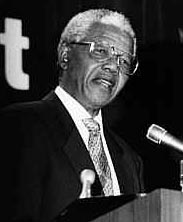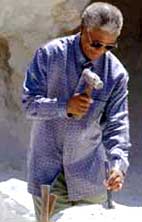Course home
page
Assignment
What combination of policies and events caused
the previously nonviolent Nelson Mandela to reverse his position in order
to gain multi-racial democracy for South Africa?
Background
Nelson Rohihlahia (stirring up trouble) Mandela
was born on 18 July 1918, near Umtata, in the Transkei region of South
Africa. His father was Chief Henry Mandela of the Tembu Tribe.
Mandela was trained to become the next chief to rule his tribe, but he was
also a determined student and eventually joined an all black college, Fort
Hare, where he was expelled for joining a student boycott. He later
obtained an arts degree in Johannesburg and studied law at the University
of Witwatersrand.
Before apartheid, South Africa had a long
history of racial segregation. In 1910 parliamentary membership was
limited to whites, and legislation was passed in 1913 to restrict ownership
of land by blacks. The African National Congress (ANC) had been formed
in 1910 to fight these policies. In 1944, the ANC President Alfred
B. Xuma started recruiting younger and more outspoken members like Walter
Sisulu, Oliver Tambo and Nelson Mandela, the first members of the ANC Youth
League (ANCYL).
In 1949, the Programme of Action was written
by the ANCYL and adopted by the ANC which advocated boycotts, strikes, civil
disobedience and noncooperation to achieve its goals. Mandela also
co-authored the "ANCYL programme", which called for full citizenship, direct
parliamentary representation, land redistribution, trade union rights, education
and cultural equality for all South Africans. This was followed by
the Campaign for the Defiance of Unjust Laws in 1952, calling for mass
disobedience starting with volunteers and involving more and more ordinary
people. Mandela traveled the country organizing resistance to
discriminatory legislation, often referred to as the "Black Pimpernal" by
the press because of the disguises he used to avoid police. Mandela
was arrested for these actions and convicted of contravening the Suppression
of Communism Act. He was given a suspended sentence, prohibited from
gatherings and confined to Johannesburg for six months. It was during
this confinement that Mandela passed the attorney's admissions examination,
and he and his long time friend, Oliver Tambo, opened the country's first
black law partnership with the help of Walter Sisulu.
Apartheid had become the official
political
policy in 1948, which caused membership in the ANC to greatly
increase.
After the Sharpville massacre in 1960, when police killed 69 and
wounded
180 unarmed African pass protesters, Mandela convinced the nonviolent
ANC
to form a military wing, known as Umkhonto we Sizwe (Spear of the
Nation),
which soon launched a campaign of sabotage against the
government.
At the same time, the government banned all black political
organizations
to include the ANC and kept a close watch on Mandela. In 1962,
Mandela
left the country to train militarily. Upon his return, he was arrested
for
leaving the country and sentenced to 5 years imprisonment and two years
later
sentenced to life for treason and sabotage in the Rivonia Trial.
(It has been alleged by many--though never conclusively proven--that
the CIA tipped off the South African government about Mandela being out
of the country and that this is how the government knew when and where
to arrest him upon his return in 1962. The evidence includes
London newspaper reports in The
Guardian on 15 August 1986 and The Times on 4 August 1986.) By
the end of the 1960s, opponents to apartheid were being arrested at the
rate
of 600,000 per year.
Nelson Mandela spent 1964 to 1982 incarcerated
in the maximum security prison on Robben Island, then moved to Pollsmoor
Prison in Cape Town and finally to Victor Verster Prison near Paarl.
Mandela's reputation grew steadily during his prison years, and he was often
looked up to by fellow inmates. The government often offered Mandela
a pardon if he would settle down in Transkei, but P.W. Botha offered the
pardon only if Mandela agreed to denounce violence. Mandela's steadfast
refusal to compromise his political position to obtain freedom, made him
a leading symbol of the anti-apartheid movement.
The ANC became an underground organization from
the 1960s to the mid 1980s, while the government continued to implement a
series of reforms to further oppress South Africans. These actions
were criticized internationally and helped to win anti-apartheid favor around
the world. By the late 1980s, the mass democratic movement pushed the
white leaders of South Africa to engage in conversations with exhiled ANC
leaders in 1988 and 1989. President F.W. de Klerk made the decision
to release Nelson Mandela in February of 1990 after he had spent 27 years
in prison. The ANC's consistent principle of non-racial democracy
created a basis for trust, which led to further talks between political parties,
black and white. A transitional constitution was then developed at
the World Trade Center in Johannesburg from 1991 to 1993, and this led to
a new Government of National Unity. Mandela and de Klerk were awarded
the Nobel Peace Prize in 1993 for their efforts in negotiating an end to
apartheid. In 1994 multi-racial elections occurred, and Nelson Mandela
became the first black President of South Africa.
Mandela dedicated his life to the struggle of
ending apartheid policies in South Africa, never wavering from his position
to seek equality for all races to include whites, and he has given more of
himself in doing so than most activists. Yet, he remains a modest man
who shows a total lack of bitterness or revenge for the years of lost freedom,
his lost family and the loss of so much life. It is these qualities
which make Nelson Mandela one of the great moral and political leaders of
our time.
Timeline
-
1910, South Africa's parliamentary
membership limited to whites.
-
1912, the African National Congress
(ANC), a nonviolent civil rights group promoting the interests of black Africans,
was founded.
-
18 July 1918, Nelson Mandela was born
in Umtata, the Transkei region of South Africa.
-
1944, Mandela joined the ANC Youth
League.
-
1948, Apartheid became the official
political policy of South Africa. Laws classified people according
to racial groups, determined where each group was to live, prohibited social
contact between races and denied representation of non-whites in the national
government. Nelson Mandela became actively engaged in apartheid
activities.
-
1949, ANC adopted a nonviolent Programme
of Action.
-
1952, Mandela opened the first black
law partnership in South Africa.
-
1952, Campaign for the Defiance of
Unjust Laws launched by the ANC.
-
1952, Mandela arrested, convicted
for crimes against the Suppression of Communism Act and given a suspended
sentence.
-
14 June 1958, Mandela married his
second wife, Winnie.
-
1960, Sharpville massacre in which
69 killed and 180 wounded.
-
1960, Military arm of the ANC, called
the Umkhonto we Sizwe, formed.
-
1960, ANC and all black political
organizations are banned.
-
5 August 1962, Mandela arrested and
sentenced to 5 years of hard labor in prison.
-
12 June 1964, While already in prison,
Mandela further sentenced to life imprisonment for sabotage and treason.
- 14 August 1989, P. W. Botha quit as president; 15 August De Klerk succeeded
him.
-
February 1990, Mandela released from
prison and assumed leadership of the ANC, leading negotiations with the
government for a new constitution that ended apartheid.
- 7 June 1990, South Africa lifted the emergency decrees.
-
7 July 1991, the first national conference
of the ANC held, and Nelson Mandela elected President, while his friend and
colleague, Oliver Tambo, became the National Chairperson.
-
1991 to 1993, a new constitution for
the Government of National Unity was developed at the Johannesburg World
Trade Center.
-
1993, Nelson Mandela and South African
President F. W. de Klerk share the Nobel Peace prize for their efforts in
establishing democracy and racial harmony in South Africa.
-
1994, After the country's first
multiracial elections, Nelson Mandela became the first black President of
South Africa.
-
May 1995, South Africa approved a
new constitution which barred discrimination against minorities, to include
whites.
-
March 1996, Nelson Mandela formally
divorced from Winnie Mandela.
WWW sites
There are many sites devoted to Nelson Mandela,
his life, his struggle to end apartheid and his current position as President
of South Africa. Some of the best sites are:Facts
on File and South
Africa's Government of National Unity. Sites which offer commentary
on and recognition of his achievements, include the Boston
Globe for his
Nobel
Peace Prize, the Peace Prize lecture and the most complete list of honors
awarded.
The African
National Congress home page provides the most inclusive collection of
information on the history of apartheid and the revolution which brought
the ANC into power. Not only are major events of the apartheid era,
such as the
Rivonia
Trial covered, but also the key persons and groups that contributed;
Oliver Tambo,
Walter Sisulu,
Umkhonto
we Sizwe, and many others. This site also contains the most
comprehensive collection of
speeches by Mandela.
Two of his most important speeches include his speech on his
Release
From Jail (1990) and his
Inaugural
Address (10 May 1994). Another
site which details the rise and fall of apartheid is the
South
Africa U.S. Embassy.
Robben
Island, which housed the majority of revolutionaries against apartheid,
to include Mandela, has now been designated as a National Museum and cultural
heritage site.
Others.
Recommended Books
For a personal perspective of the trials and
tribulations of his life, read
Long
Walk to Freedom: The Autobiography of Nelson Mandela (1995).
A less detailed accounting may be found in Mandela: An Illustrated
Autobiography (1996). Nelson Mandela: The Struggle
Is My Life (1992), is a collection of speeches and writings which
explains Mandela's political beliefs. Mary Benson, Nelson Mandela,
The Man and the Movement (1986) is a sympathetic biography and portrait of
Mandela that relies, in part, on prison interviews.
The book Goodbye Bafana: Nelson Mandela,
My Prisoner, My Friend is a touching tribute to Mandela from a former
prison guard James Gregory, whose hatred for blacks was reversed after getting
to know and becoming a friend of Mandela.
Documentary information:
Related Events
Gandhi
The Art Scene in South Africa Since 1948
|



